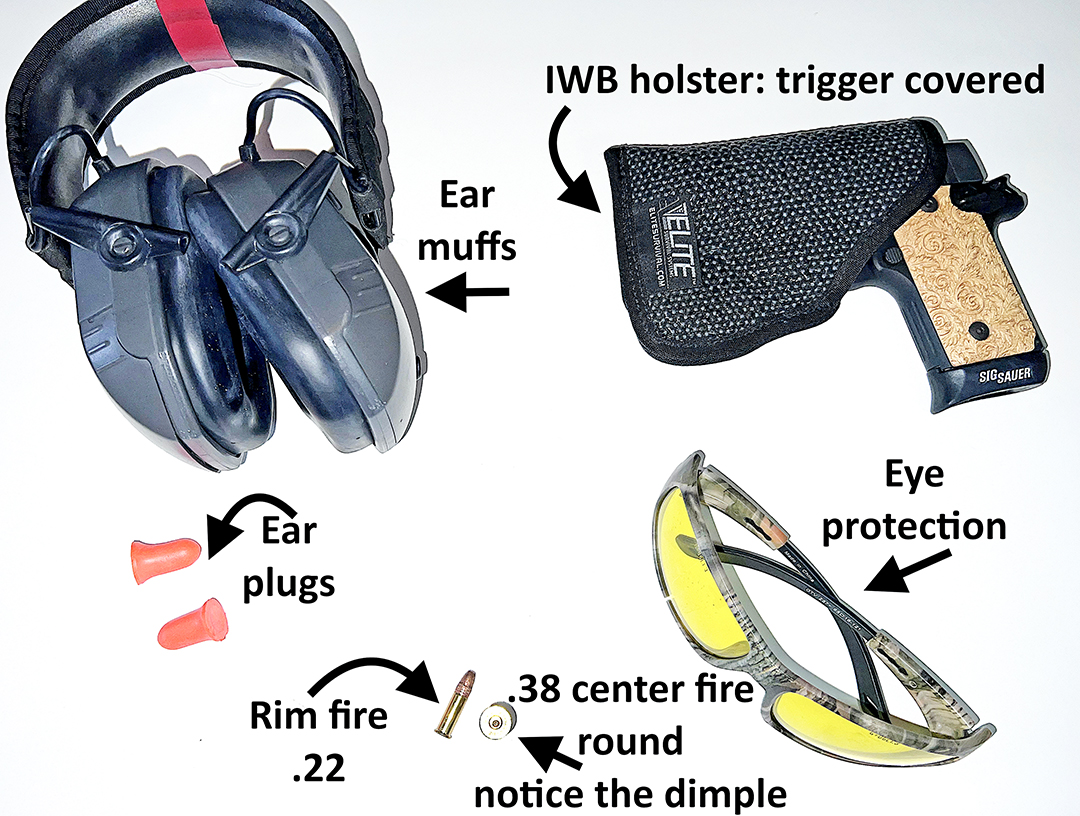Little facts that matter, Part 2

By MARJ LAW

EYES AND EARS
Newbies and oldies alike need “eyes” and “ears.” It’s a rule at the Wakulla County Sheriff’s Office (WCSO) range, as well as at most other ranges.
“Eyes” refers to eye protection. Hot shells flying out of your ejection port can go anywhere. If they come towards your face, you sure don’t want them to hit your eyes. They are hot and sharp. Many stores have ANSI-rated wrap-around eye glasses. The good news is that they are very inexpensive: usually around $5.00.
And “ears?” You guessed it. Hearing protection. Sudden loud noises can damage your hearing. From ear muffs you wear to squishy pads you put in your ears, hearing protection can range from $1 to… whatever you want to spend. But a decent pair of muffs that muffle sudden sharp loud sounds and still allow you to hear someone declare the range “hot” or “cold” can cost you under $55.
HOT AND COLD
Almost every range, including the WCSO range, observes “cold” and “hot.”
These two words help keep you safe.
When a range is “cold,” it means that nobody touches a gun. The WCSO pistol range has a painted red line that is drawn clear across from one side of the range’s cement floor to the other. When the range is cold, you have to stand on the side of the red line closest to the parking lot.
Since guns don’t fire by themselves and since no one is now able to touch a gun, then it’s not possible to accidentally shoot someone who may be putting up a target downrange.
When everyone has finished putting up targets, and they all come behind the red line, then they can all agree to go “hot,” which means they can now step over the red line and load and shoot handguns.
It is important to make sure everyone at the pistol range knows and agrees when the range is hot or cold.
CALIBER
“You have to go for shooting power,” he declares. “You can’t defend your life with a .22, or a .380. Even a 9mm is too weak a load to take down a guy hopped up on drugs.”
Is this true? Should Newbie choose a .38, a 10mm, or a .40 or .45-caliber handgun instead?
A male relative near and dear to me brings his girlfriend to the WCSO range. He lays a .40 caliber handgun on the shooting bench.
“This is the gun we have at home for defense,” he states firmly, “so this is the gun my gal is going to shoot!”
“And she’s never shot before?” I ask. “May I show her our .22?”
“No. This is it.”
So, he shows her how to hold the gun. He tells her to squeeze the trigger. She does.
Blam!
Her hands shoot up in the air.
“I think I’ll just watch you,” she says as she sits down.
This is something you don’t do to Newbie. I’ve seen (humorous???) YouTube videos of a gal whapping herself in the forehead just like this gal did. It is not funny. It is thoughtless and dangerous.
After waiting a while, I ask her if she would like to shoot my Ruger Mark III .22. She says “no” at first, but I reassure her that she will be able to manage a .22. She is naturally well-coordinated and athletic.
We discuss hot and cold, pointing the muzzle downrange at all times and keeping our fingers off the trigger until we are ready to shoot.
Blam!
“That was easy!” she says happily.
“And you’ll do even better when you keep your eyes open next time!”
After shooting the .22 for a while, she tries a 9mm handgun and is still enjoying herself. She feels ready to shoot the .40. She is confident and shoots the .40 well.
Most of us learn to crawl before we learn to run. That’s a natural progression of development. The same works well for shooting handguns.
Out of .22, .380, 9mm, .38, .40 and .45 caliber handguns, the .22 is the smallest round with the least powder to set off its small projectile. This amounts to the least recoil of the above rounds. The other rounds are progressively larger with more powder. Shooting the .22 first helps Newbie to learn about proper stance and grip. She learns how to squeeze the trigger and how to aim her particular gun. The .22 is a great gun to learn on.
Of course, most newbies can’t afford to purchase a gun of each caliber. In this case, Newbie can rent a gun at some ranges. Once proficient at a low caliber, Newbie can work her way to the highest caliber she feels comfortable with shooting repetitively.
This gun should be in her comfort zone, or she won’t want to practice. If she doesn’t spend any time practicing, will she be able to defend herself if that awful day ever comes?
This is why there is no “best” caliber handgun. While it is true that a higher caliber handgun is likely to have more “take down” power, if Newbie can’t manage it, it’s no good to her.
So, Newbie, don’t let anyone bully you into buying something you can’t handle.
RIM-FIRE AND CENTER-FIRE
.22s are rim-fire rounds. Look at the back of the casing. It might have a letter, like an “F” for Federal. That’s the brand name of your round.
When you shoot, the firing pin that whacks the back of the casing to set off the powder, hits the rim of this casing: hence rim-fire.
Now look at the back of a .38 casing. First of all, the whole casing is a lot larger than the .22’s.
Notice the round circle in the middle of the back of the casing. This is where the firing pin hits. This pictured round has been shot. A dimple in the center of the casing’s back shows that the firing pin did indeed whack within this circle.
CARRYING
Do you plan to carry your gun? Or, now that you have one, do you plan to lock it in a safe?
Owning a handgun and knowing how to use it can give you a sense of security. Just think how secure you’d feel if Mr. Bad broke into your house and your gun was oh-so-safely locked away?
“Stay right there, Mr. Bad. Got to find the key to the safe.”
You do want that safe for when the grandkids come to visit, but it will provide no protection when you’re alone and Mr. Bad is crashing down the door.
Are you planning to carry in a purse? Then, when you lunch with friends, your purse is usually draped over the back of your chair. Easy for someone to swipe and dash.
Going to the restroom? Will you hang your purse on the door’s hook? A clever, watchful person can grab it then too.
And a not-so-clever person exactly my age once left her purse in a Winn Dixie parking lot buggy. Fortunately, she wasn’t carrying in her purse at the time. And so fortunately, a Winn Dixie attendant discovered it and brought it to the office. Intact.
The most accessible place to carry is on your person. When you see the initials IWB, it means a holster is made to wear “inside the waistband.” You can also carry OWB, which means “outside the waistband.” Always use a holster so the gun doesn’t get filled with pocket debris, and so the gun is at the correct angle for drawing, the trigger is covered properly, and the gun doesn’t slide out of your clothing.
In Florida, we need to make sure the gun does not show and that it does not “imprint” under clothing. It must be concealed.
Rules for carrying vary, depending on your state. When traveling, check each state along your path. If you’re carrying to a different state, and you want to be super careful in every state, then provide 2 lockboxes in the unoccupied area of your car such as the trunk: using one for your unloaded gun, and one for your ammunition.
Last week in The Wakulla Sun, we discussed how to show a gun, how to tell if your gun is a hammer gun or a striker fired gun, how to tell if you have a single or double action gun, and how to notice differences between guns you might choose.
These are a few thoughts to keep in mind when buying your new handgun. And always, find a way to try the gun you want before you buy it.
The Wakulla Sun is located in the middle of Crawfordville. They keep copies and they have a web page if you want to read back issues.
There are so many things to consider when you buy or have bought a new gun. Stay tuned for Part 3: Kicking the Tires on a New Gun.
Marj Law is the former director of Keep Wakulla County Beautiful who has become an avid shooter in retirement.
